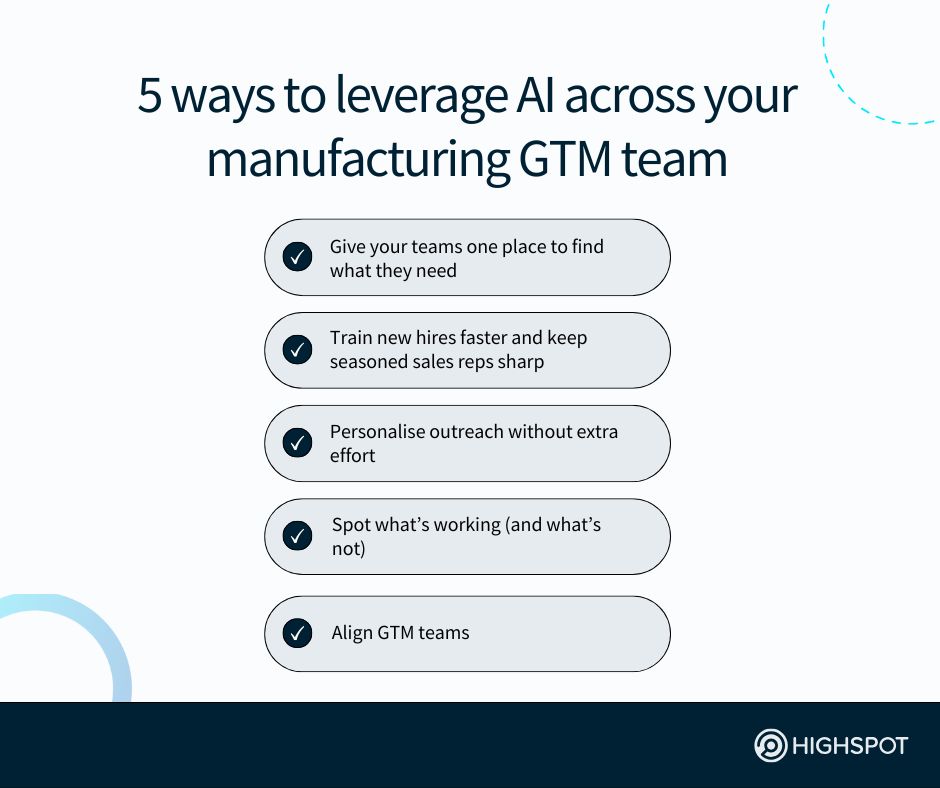Key takeaways
- By leveraging AI across the entire sales cycle, inside and outside sales reps at manufacturers can save time and streamline critical sales tasks.
- Manufacturing companies that embrace AI in their go-to-market (GTM) enablement programmes see up to 20% higher revenue outcomes today.
- The use of AI-powered coaching helps manufacturing GTM teams deliver targeted training and coaching to sharpen reps’ skills without disrupting workflow.
Manufacturing sales teams face long deal cycles with cross-functional buying committees who have complex product requirements. What’s more, they often navigate highly technical buyers, strict procurement processes, and tough competition.
That is why every interaction inside and outside sales reps at manufacturing companies have with potential customers must be personalised, timely, and value-driven.
The issue manufacturing sales teams face, though, is a big one: Outdated systems and technology and data silos deter effective sales rep preparation, which slows everything associated with their GTM efforts down.
Fortunately, innovation in AI is helping to reduce the chaos and boost their sales efficiency.
When manufacturing sales teams, including distributors and channel partners, are prepared with relevant sales collateral, consistent messaging, and the tools and resources to build and maintain relationships with buyers, they ramp faster, work smarter, and close more deals by adding real value to prospects.
Whether you sell machinery, building supplies, or vehicle parts, leveraging a unified, AI-powered enablement platform with rich analytics is invaluable, as it can lead to faster deal cycles, higher closed-won rates, and more predictable revenue growth.
How AI-powered enablement improves manufacturing sales
An AI-powered sales enablement platform acts like a smart assistant. The solution automates repetitive, administrative tasks, surfaces relevant content, and gives reps real-time guidance during the sales cycle.
Every follow-up becomes more tailored, with AI recommending sales assets based on what’s worked in similar deals. That way, reps can focus on building relationships, not time-consuming, back-office admin tasks.
A common concern when people hear “AI” in sales is that it might replace sales reps altogether, but that’s not the reality.
“When AI is everywhere, it’s the personalised, human moments that capture—and keep—a buyer’s attention,” the Highspot State of Sales Enablement Report 2025 explains. “Across the board, companies are implementing tools to support reps in delivering those moments at scale.”
5 ways to leverage AI across your manufacturing GTM team
Want to realise results like Hyster-Yale Group? All you need is to adopt a best-in-class GTM enablement platform and follow these five best practices leading manufacturing sales teams abide by to sell smarter and faster and better coordinate with their sales and enablement colleagues.

1. Give your teams one place to find what they need
Every sales rep spends way too much time searching for the most up-to-date tech specs, pricing, or region or industry-specific content.
When managing large catalogs and diverse product lines that change with each potential customer’s unique business, disorder can tank productivity.
Clean up content by using feedback from sales teams, usage metrics, and AI to tag assets by persona, product, content type, or deal stage.
Instead of spending hours manually tagging docs, videos, and other content, AI does the time-consuming work, so everything is easy to find, use, and keep up to date.
It reduces content waste because if a sales rep can find the resources they need, it’s far more likely they will actually use them. For example, Ritchie Bros. improved content findability by 88% and boosted buyer engagement by 76% after centralising all sales and content marketing materials in Highspot.
2. Train new hires faster and keep seasoned sales reps sharp
Ramp times in the manufacturing industry are intense, especially when trying to grasp the long sales cycles, complex products, and layered buyer committees. Every extra week a new sales rep takes to get up to speed can often feel like lost revenue.
But as Forrester VP, Principal Analyst Peter Ostrow recently said, “the long-term deficiencies engendered by insufficient ramping quality are far more painful than the advantages of a week or two’s time saved on the front end of a seller’s multiyear career.”
The pressure is real, because the moment a rep starts drawing salary, most teams expect immediate ROI.
The good news? The right AI-powered sales enablement tool can enhance onboarding and accelerate time to value for your manufacturing sales organisation.
Instead of relying on historical knowledge that new reps just don’t have or burying new hires in standardised onboarding decks, AI taps into conversational intelligence—insights pulled from real buyer interactions and call transcripts—to identify skill gaps and build personalised learning paths.
This AI functionality helps new sales hires ramp faster by grounding their training in actual sales conversations and behaviours across the deal cycle.
It also keeps seasoned sales reps sharp with continuous learning and coaching tied to events like launching new SKUs, expanding into new verticals, or handling technical objections.
Leaders also benefit from AI role play for sales managers that simulates real buyer scenarios. McKinsey’s research found that organisations investing in AI-driven enablement experience a 10–20% increase in sales ROI, with increased productivity contributing as much as $660 billion in annual value across industries.
Start small with a few use-case-specific learning tracks for new hires, then expand as you learn what works.
SkinCeuticals, for example, cut onboarding time by 25% and experienced a 15% shorter sales cycle by centralising content and delivering consistent, AI-powered training through Highspot.
New reps were ramped up in just 30 days, while seasoned sellers gained fast, in-context access to coaching resources without disrupting their workflow.
Related resource: The Future of Sales Coaching: How AI Drives Sales Success
3. Personalise outreach without extra effort
Personalised outreach improves engagement, but in manufacturing companies, it’s rarely simple. The stakeholders involved have distinct roles:
- Sales and GTM engineers want specs and proof
- Procurement cares about cost, risk, and ROI
- End users (reps) want an intuitive software UI
Decision-makers and buying committee members aren’t always communicating with one another, so each expects relevant messaging and content tailored to their personal pain points.
The challenge is that most sales reps don’t have a deep understanding of customer needs, nor the time to tailor every interaction manually.
But AI fixes this by recommending the right collateral, messaging, or follow-up actions based on deal stage, persona, or buyer behavior.
If a sales rep or channel team is working with an engineering lead in the evaluation stage, AI can surface a technical comparison sheet and a case study from a similar vertical without digging through a content library or guessing what to send.
If that same deal moves into procurement review, the system might recommend ROI calculators, pricing FAQs, or some other form of value justification tailored to that persona.
Hyster-Yale, for example, saw a 19% increase in buyer engagement and a 68% increase in play adoption after using Highspot to power AI-driven content recommendations.
Sales reps and channel partners could easily personalise every interaction, resulting in more relevant conversations, higher rep confidence, and better sales outcomes.
4. Spot what’s working (and what’s not)
It’s hard to improve what you can’t measure. Many manufacturing GTM teams struggle to connect content, training, and sales rep actions to actual deal outcomes. Without data-driven insights, they have no idea what’s being used, what’s landing with buyers, and what’s stalling deals.
Using intuitive, AI-powered sales analytics give you that clarity.
By connecting outcomes to CRM records, you can track which content is used and when, which engagement activities move the needle, and what activities correlate to stalled deals. This allows your sales leaders to focus on coaching, content strategy, and pipeline support where it has the biggest impact.
Of course, all of this hinges on trust. In manufacturing, where proprietary specs, buyer conversations, and sensitive customer data are involved, data governance is non-negotiable.
That’s why centralised platforms like Highspot are designed to meet SOC 2 Type II, ISO 27001, and GDPR standards. And, for manufacturing teams managing AI-specific risks, the NIST AI Risk Management Framework offers clear, practical guidance for deploying AI securely and responsibly.
5. Align GTM teams
Once you know what’s working, the next step is ensuring everyone is working together. Misalignment between sales, marketing, product, and channel teams often leads to duplicated work, inconsistent messaging, and lost opportunities.
Deploying AI across your sales and marketing teams helps break down those silos by creating shared visibility across GTM.
With centralised sales enablement platforms, field feedback is directly integrated into future content updates, product launches receive the right level of advocacy and support, and AI informs every team on what resonates with buyers. Instead of guessing, teams can quickly pivot when necessary and align around proven sales plays and strategies.
Siemens is a prime example.
By using Highspot to improve partner enablement and GTM productivity, they achieved over 100% improvement in annual revenue growth targets and continued long-term development momentum.
Unfortunately, distributors and channel partners are often on the sidelines, left to piece together outdated materials or guess at messaging that may or may not be current.
An AI-driven partner enablement strategy ensures they receive the same high-impact content, guidance, and support as your internal teams, without incurring extra overhead for your GTM teams.
By automatically surfacing the right resources and offering personalised coaching for continuous improvement, AI helps partners represent your brand consistently in the field.
GTM enablement readiness scorecard for manufacturers
Wondering where your team stands in terms of AI-powered sales enablement for manufacturing? This quick scorecard helps you evaluate how prepared your GTM organisation is across the fundamentals.
For each statement, rate your organisation as yes, somewhat, or no.
If you answer mostly ‘yes,’ you’re AI-ready; somewhat ‘yes,’ you’re getting there, and AI in sales can help connect the dots. If you answer mostly ‘no,’ start with centralising content and onboarding, because that’s where manufacturers will see fast wins.
| Category | Details | How do you score? Yes, somewhat, or no |
|---|---|---|
| Content findability | – Sales reps can find accurate specs, pricing, and compliance docs in under 2 minutes. – Our content is tagged by persona, product, and region. – Marketing knows what content sales actually use. | |
| Onboarding & coaching | – New hires ramp in 30–60 days using structured, role-based content. – Managers can coach using buyer conversation data and AI feedback. | |
| Personalisation at scale | – Sales outreach adapts to the buyer role (think engineer vs. procurement). – Reps are served smart content recommendations tailored to their deal stage. | |
| Data & deal visibility | – We can tie sales enablement activities directly to deal outcomes. – We track which assets drive buyer engagement. | |
| GTM team alignment | – Sales, marketing, and product collaborate using shared insights. – Our channel partners have access to the same enablement materials and central platform. |
How to make AI enablement stick in manufacturing
Rolling out effective sales enablement doesn’t have to be a massive overhaul. But, like any change, success depends on your starting point and how you prepare your teams.
The key is a strategic approach that focuses on one high-impact pain point that your teams experience every day, like content chaos or inconsistent onboarding. When you solve something that people genuinely care about, adoption builds naturally across the organisation.
That said, there are a few common missteps to watch out for:
- Overloading sales reps with too much, too fast: Even great automation tools fail when they’re introduced all at once with no clear use case.
- Forgetting to include channel partners: Distributors need the same clarity and resources as internal teams, or your brand experience breaks down in the field.
- Skipping early wins: If you’re not tracking quick, measurable improvements, it’s hard to build momentum or justify the investment.
Instead, think of implementation as a phased rollout. Start where the friction is highest and show how AI removes it.
As adoption grows, so does your confidence and ability to expand into other parts of the GTM and sales process. AI eventually sticks because it makes life easier for the people using it every day.
It’s time to equip manufacturing sales teams for what’s next
Manufacturing sales teams face complex buyer journeys, long sales cycles, and rising buyer expectations. To compete, you need a smarter manufacturing sales enablement strategy with integrated customer relationship management (CRM).
With unified enablement tools that have an AI and analytics engine like Highspot, GTM teams can align around what works, eliminate manual data entry, and focus on equipping sales teams with relevant content that shortens sales cycles and wins more deals.
Bottom line: Incorporating AI into your manufacturing sales process is your best path to strengthen your sales operation and drive predictable revenue growth.




